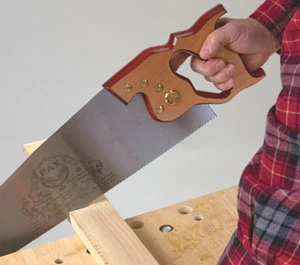Still useful after all these years.
Power saws dominate the home project scene, and have for more than five decades now. Yet a handsaw is often the fastest and easiest way to do a small, or moderate-sized, job in wood, plastic or metal. The need is less today than it was when I began working with an old Polish carpenter who thought I was the slowest helper he’d ever had, but it still exists.
Today’s handsaws are the result of thousands of years of development, from the first Stone Age versions chipped from local rocks to the more accurately patterned metal shapes of the Bronze and early Iron Ages, to today’s incredible variety of very tough steels in many alloys, with many treatments. The first saws were used for everything—a single pattern for multiple jobs. That still often works, but a panel saw, essential for cutting lumber to length or width, is quickly ruined—as it wastes the user’s energy—when doing jobs such as pruning brush and trees, while using a hacksaw on wood is a taxi ride to the nuthouse.
Why Use Handsaws?
Handsaws today are convenient and quick. Handsaws are ready to go when picked up. Power tools require a cord, an extension cord, or batteries which must be kept charged … and often aren’t ready for an hour. For smaller jobs, being able to grab and go is a big plus. Handsaws are cheaper than power saws (quality being equal). Not needing electrical power is essential when you’re a long way from an outlet.
One secret to getting the best results, while using the least energy, with any tool is correct selection for the job’s purposes. There are handsaws for all materials, whether wood, plasterboard, plastic or a variety of metals. With some materials, handsaws give better results than power saws. Acrylic and other plastics may melt at higher power saw speeds, but cut nicely with handsaws.
Another simple secret: Keep a handsaw in good shape, sharp and free of rust, stored in a manner that doesn’t crook the blade.
Where to Begin
Simplicity hides when it is time to select a saw, or several saws. Buying handsaws you won’t use just because you like their looks or the sales pitch is a fantastic way to piddle away money. Yet it’s a good idea to have a selection of handsaws for those just-in-case jobs.
Saw selection starts with type, then moves to a set of initials you’ll often see, tpi, or Teeth per inch, which is a classification that can show performance. Wood cutting panel saws range from 5-1/2 Points per inch (ppi) for cutting with the grain (ripping) to 25 ppi (for very fine crosscutting, usually found in Japanese saws). Today, few people use rip saws. Most how-to work is easily done with saws ranging from 9 ppi (coarse) to 12 ppi (fine). To get tpi, subtract one from the points-per-inch number. Either is a sign of cut smoothness; the more teeth or points per inch, the smoother the cut. Rip saws use a chisel pattern tooth to chip out the wood, while crosscut saws use a knife edge to slice through the fibers. Rip saw teeth are filed at 90 degrees to the face of the blade; crosscut saw teeth are sharpened at an angle, usually about 65 degrees. Both saws have teeth set at an angle to the blade. Set is fixed, and determined by the tool used to produce it.
For crosscut saws, use coarse teeth (8 tpi) and a wide set for green lumber, fine teeth (10 or 12 tpi) and a closer set for dry, seasoned lumber to be used for finish work.

Saw Types
Panel saws are needed in many areas, and use the rip/crosscut categories. Blade lengths vary, but the big change these days is in the method of shaping the teeth. Stanley’s SharpTooth is a design that allows high speed cutting using both the push and pull strokes. The teeth are induction hardened. The line is wide, going up to 26-inch, 12-point fine cut saws.
Pax saws, from Thomas Flinn (sold by Lee Valley) in Sheffield, England, are panel saws made to traditional patterns, ground thin towards the back and top of the saw to prevent binding, made of high carbon steel to take an especially sharp edge. The Pax saws are more for the tool enthusiast who also has practical need for such a saw, as their cost is more than triple that of the Stanley saw.
Toolbox saws are among the most useful of the panel saws for the many of us. Toolbox saws have blades short enough to let them fit in a toolbox or toolbag of reasonable size. Overall the saw is seldom more than 20 inches. Such saws force a short, choppy sawing motion. If you anticipate much hand saw work, buy a longer panel saw, with a 22- to 26-inch long blade. Sawing motion is easier and smoother. In deeper cuts, a smoother action helps prevent binding. Folding saws are extremely handy in toolboxes, including folding Japanese and pruning saws.
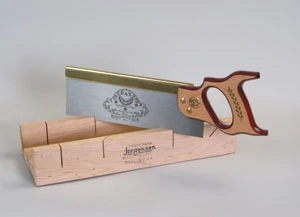

Backsaws are handy when you need precise cuts, whether for depth or angle. A rib along the back of the saw keeps the blade very rigid. With little or no flex at the teeth, the cut can be very precise. Backsaws are usually seen today with miter boxes, but are available in versions for freehand work, plus dovetail and tenon versions for finer woodworking.
Making a Cut
Starting a handsaw cut is simple. Use your left thumb knuckle—I’m right-handed, so change hands if needed—to guide the saw blade as you push it for the first few inches of the stroke. Some people use the tip of their index finger to guide the start. Whichever way you select, start smoothly, with as little force as possible to prevent the saw jumping and cutting your knuckle or finger tip.
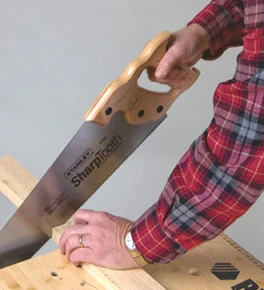
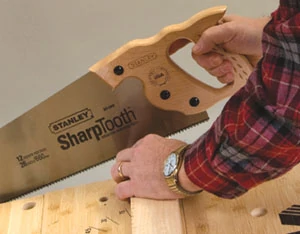
Then cut with the saw teeth held at about a 45-degree angle to the work surface. Push, pull, and keep the strokes as straight and smooth as you can. As with all physical work, practice helps. Great power isn’t needed.
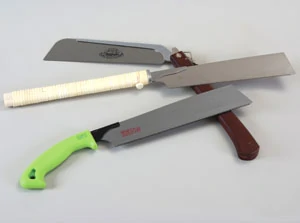
Starting a cut with a Japanese pattern saw or a Stanley Sharptooth is even simpler. Place the teeth at the line, and draw the saw to you. The saw cuts on the pull stroke, making it easier to start than the European-pattern saw that most of us are used to. Japanese saws have thinner saw blades than European saws. Even on a pull stroke, these blades flex more, needing attention so the cut doesn’t wander. Japanese rip saws are a wonder, while the very fine-toothed crosscut saws—as many as 25 tpi—produce incredibly smooth cuts. They’re preferred by many who do fine woodworking because of the very fine kerf (saw cut slot) they make, plus the smooth finish in the cut. Many versions are available, including backsaws, rip and crosscut versions.
Other Handsaws
Pruning shears run out of oomph at less than 1-1/2 inches, but a good pruning saw, whether the bow saw type or any of the others, continues going until the branch to be removed is much thicker. If you think about chainsaw use for thicker branches, don’t. Using a chainsaw overhead is extremely dangerous. You also need to get the saw, the bar oil, the gas mix all ready. Get the saw running. Carry the poundage out to the trees. With a good pruning saw, you pluck it off its nail on the wall, go to the work and start.
Bow saws are good for cutting firewood, when you only need a few small logs.
Utility saws, such as hacksaws are useful, too. When cutting metal, or material other than some of the softer aluminum alloys that are readily cut with fine-toothed handsaws, a hacksaw is a must-have. It cuts plastic or iron pipe, cable bar stock, angle iron or sheet metal (to a limited depth), with equal facility. Hacksaw blades have fine teeth with thin blades. Most often, hacksaw blades have no fewer than 12 tpi, even one used for bar stock. Many run up to 32 tpi. The rule of thumb says at least three teeth in the work when starting a cut with a hacksaw. Hacksaw cuts are begun at a much lower angle than are those made with a panel or backsaw, roughly between 10 and 15 degrees, so more teeth tend to meet the work.
The hacksaw was sometimes called the plumber’s saw, because it was used for slicing through nails met as holes and passageways were cut for pipe, while also being ready to cut the pipe. Today, it’s that and much more, with carbide-coated and carbide rod blades for materials such as ceramics and glass. Special steel blades make cutting in stressed positions easier—the blades don’t break as easily. Most of the blades are cheap, and changeover is easier than ever on newer saws.
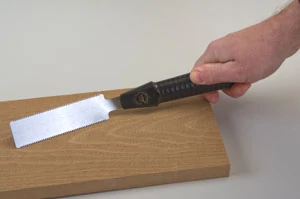
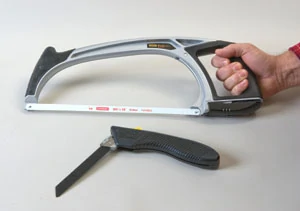
Jab saws are for opening up a wall and cutting out a spot for a fixture, electrical box or similar needs. There are many versions, but Stanley’s folding pocket saw (15-333) is a prime example. The handle is large and comfortable. The saw blade works over a wide range because it is made for reciprocating saws. A fine-cut version comes with the saw, to cut metal, plastics, wood and drywall. Many blade types are available at low cost. Jab saws replaced the old keyhole saw. They work better on more materials, last longer and are easier to carry around.
Flush cut saws are thin-bladed saws allowing an easy flush-to-the-work-surface cut by a blade that doesn’t damage the undersurface. Lee Valley’s Veritas flush cut saw offers 22 tpi, with teeth set only on one side. That leaves the smooth side down, so the surface underneath isn’t marked. Most Japanese flush cut saws use blades with no set at all. Either way works. Blades are short, very flexible, and tough. The saws are useful for trimming anything when the remaining surface must be unmarked, such as dowels, trim, cleaning up tenons in woodwork and so on.
The Basic Saw Tool Box
Tool boxes around the home are best kept as small as possible, growing only when a need is established for a new tool. Start small, with a short, medium (10 tpi) panel saw, a hacksaw and extra blades with 18 tpi and 24 tpi. Add a jab saw, preferably a folding model.
After that, consider long panel saws for easier, more accurate cuts. Add a backsaw and miter box as needed for accurate crosscuts for molding and other uses. Add flush cut and other saws as the needs arise.
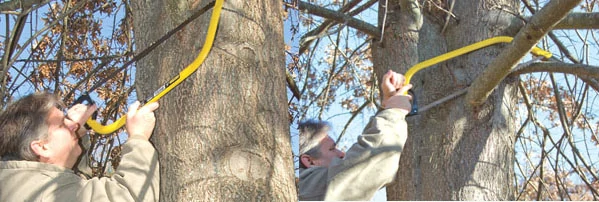
For yard work, look for a good pruning saw. Get a bow saw for heavier work. Bow saws are preferable because of their replaceable blades, a handy feature when cutting wood that may be a dried plum tree or green hackberry on the same day.
At that point, stop and think carefully before adding any more handsaws.


